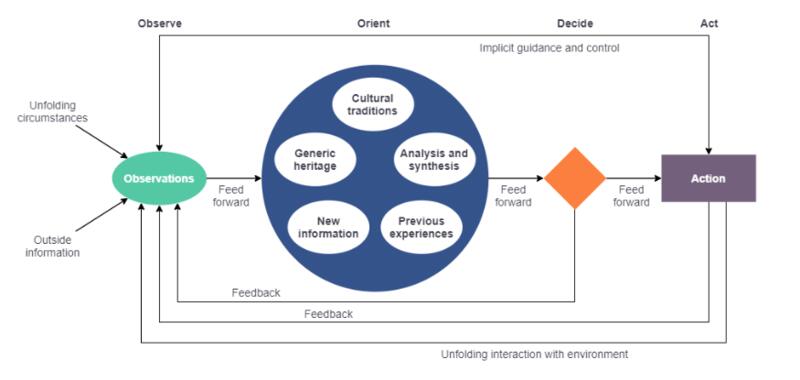
Picture yourself as a basketball player trying to make the winning shot. The defender is taller and more athletic than you, but you know you can score on them. You quickly go through a series of feigned moves left and right, testing…testing…until you have them off balance, and then you make your move - you’ve been using the OODA Loop.
Observe, Orient, Decide, and Act (The OODA Loop): You must first see (observe) what is happening. Next, you must position yourself to respond (orient). Following orientation, you must determine a course of action (decide); and finally, you must perform that act (act).

John Boyd was a 20th-century fighter pilot and military strategist who developed the idea of the OODA loop. Boyd earned the nickname “Forty-Second Boyd” during his time as a fighter pilot, referring to his ability to win a fight against the opponent in under forty seconds.
After studying historic battles and serving in World War II, the Korean War, and the Vietnam War firsthand, Boyd came to the conclusion that success was dependent on the ability to rapidly adapt and make fast decisions in an uncertain environment, regardless of which side was at a technical advantage. This idea eventually evolved into the OODA loop.
The OODA loop has been adapted to become an important concept in business, game theory, information security, law enforcement, litigation, marketing, and military strategy.
So how can the OODA Loop be applied to school staff reacting to an emergency? During an emergency, we can be placed under enormous stress. We try to mediate that stress through drills, exercises, and planning that prepare your response to any given emergency, however, the unpredictable nature of emergencies means you may need to make quick, decisive, life-saving decisions for yourself and your students. Emergency preparations then should include training on how to recognize the circumstance you are in, how to quickly analyze the situation, how to decide on a plan of action, and how to act on that decision. In order to understand the need to practice the OODA Loop, you need to understand how you may react to stress.
You may experience several common sensory side effects of high stress that many police officers report experiencing during dangerous encounters:
- Tunnel Vision - your field of focus may narrow to only the most immediate threat and you may not see peripheral details.
- Audio Exclusion - you may stop hearing what is happening.
- Time Dilations - things may seem to move in slow motion.
- Out-of-Body Experiences - you may feel as if you are outside of your body watching the event happen.
- Reduced Motor Skills - you may experience reduced efficiency of your fine motor skills.
Under these circumstances, it is important to recognize how your thinking changes under stress and marshal your ability to think rationally rather than emotionally. Being aware of your decision-making capabilities will help you react decisively.
You use the OODA Loop nearly every day, for instance;
- On your way to work, you come upon a construction zone (Observe).
- You know several other routes to get to work (Orient).
- You decide on the best alternative route (Decide).
- You quickly turn to that route (Act).
- Once you’ve made the turn the loop begins again;
- The turn didn’t work, there’s construction here too (O)
- Your options are now limited but you still know a few (O).
- You pivot to the best alternative - alternative route (D).
- You turn to that route (A).
As you see, you are well-practiced at using this thought process, your brain is familiar with it and your brain likes doing the familiar, then the trick under stress is to intentionally switch on this type of thinking. How do you do that?
Be mindful of your mindfulness. Simply being aware of your use of the OODA Loop in your everyday life helps you practice. Practice moves your thinking away from automatic thought to purposeful thought. You can use the OODA Loop when you are NOT under stress to think about what you should do in a stressful situation. It is possible to think through likely scenarios and the appropriate responses to those scenarios to prepare action scripts. When under stress, you can then access these prepared plans.
Act - freezing is almost always the wrong response. It leads to a feeling of helplessness. When people feel helpless, their stress levels increase, which further hinders functioning. Taking action - any action - can help give a sense of control and help reduce the stress response. But wait a minute, you might say, you’ve jumped to the end of the OODA Loop. How can I Act when I haven’t “OOD’d?” The most important part of the OODA Loop is indeed, the Orientation phase when you’ve recognized the situation and are considering your options. In reality, you are probably switching back and forth between Observe and Orient very quickly as new stimuli reach you. It’s important not to have “analysis paralysis” so a small action like getting to your feet or taking a fighting stance can push your brain into an active state, very similar to a startle response, it takes an action to focus the mind. Remember it’s a loop that goes around and around and around very quickly, you don’t have to make a big move, you just have to get the loop to start looping.
Notice there is a part of the loop at the top, “Implicit Guidance & Control.” The fighter pilot hasn’t stopped flying the plane, the basketball player doesn’t stop dribbling the ball. Action and thought are not mutually exclusive, they overlap. The OODA Loop is merely a way to think about your thinking when you are acting under stress. By practicing the OODA Loop you can train your brain to function efficiently during stressful situations, rapidly adapt and win when the odds seem stacked against you.
/WSD-horizontal-logo-small-RGB.png?mask=1)